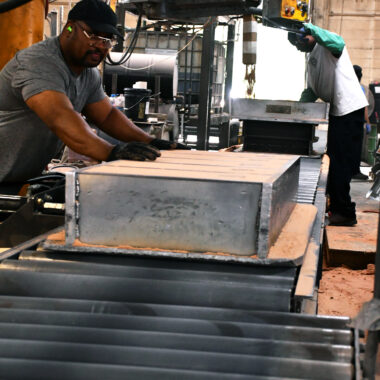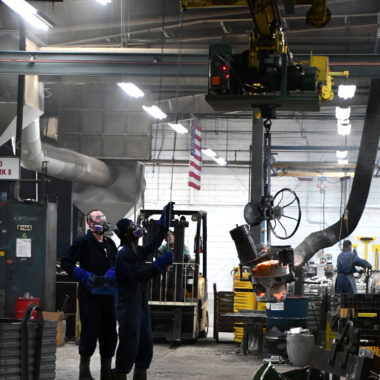About Aluminum Casting Fundamentals: Everything You Need to Know
About Aluminum Casting Fundamentals: Everything You Need to Know
Blog Article
Crafting Excellence: How to Achieve High-Quality Light Weight Aluminum Castings Each Time
In the realm of aluminum casting, the pursuit of perfection is a continuous journey that requires a meticulous approach and a keen understanding of the intricacies entailed. Attaining regular high-quality aluminum spreadings demands a comprehensive grasp of the procedures, from picking the proper alloy to carrying out exact mold designs and diligently regulating spreading parameters.
Understanding Light Weight Aluminum Casting Processes
Aluminum casting procedures, necessary in the production sector, entail the complex change of molten light weight aluminum into strong types through a collection of very carefully controlled actions. Comprehending these processes is extremely important to accomplishing top quality light weight aluminum castings consistently - about aluminum casting. The key techniques used in light weight aluminum casting are pass away casting, sand spreading, and investment spreading

Each of these procedures has its benefits and is selected based upon aspects like intricacy, quantity, and desired coating of the aluminum spreading. about aluminum casting. Comprehending the intricacies of these methods is crucial for producers aiming to generate top notch aluminum spreadings consistently
Picking the Right Aluminum Alloy
Selecting the appropriate aluminum alloy is a crucial decision in the production of high-quality aluminum spreadings. The selection of alloy significantly impacts the residential properties and attributes of the final product. Various light weight aluminum alloys provide differing degrees of toughness, rust resistance, machinability, and thermal conductivity. When selecting an aluminum alloy for spreading, it is vital to consider the particular requirements of the application to make certain optimum performance.
One of the most generally used aluminum alloys for casting is A356 - about aluminum casting. For applications calling for high toughness, 7075 aluminum alloy is a popular option due to its phenomenal strength-to-weight ratio.
In addition to mechanical residential properties, factors to consider such as cost, availability, and post-casting processes ought to likewise affect the choice of the appropriate light weight aluminum alloy. By thoroughly examining these variables, suppliers can ensure the production of top quality aluminum castings that meet the desired requirements.
Implementing Proper Mold Layout
Creating a reliable mold and mildew style is vital for making certain the effective production of premium aluminum castings. Correct mold and mildew style plays a considerable role in achieving the wanted features of the end product. To carry out a successful mold and mildew layout, aspects such as product circulation, cooling rates, and part geometry must be carefully taken into consideration.
One key aspect of mold and mildew layout is making certain correct dental filling and solidification of the aluminum within the mold and mildew dental caries. This involves designing jogger and gating systems that help with smooth steel flow and stop flaws such as air entrapment or see this site incomplete filling. check my source In addition, including cooling networks into the mold style assists control solidification rates and minimize the risk of porosity or contraction defects.

Controlling Spreading Parameters

Making Sure Post-Casting Top Quality Checks
To preserve the high quality of aluminum castings, complete post-casting top quality checks are important. After the spreading process is completed, it is important to guarantee that the last items satisfy the preferred specs and criteria.
Dimensional precision is an additional important facet that must be validated throughout post-casting high quality checks. Dimensions of vital measurements and resistances ought to be required to confirm that the castings satisfy the called for specs. Additionally, mechanical properties such as solidity, tensile stamina, and impact resistance might require to be reviewed with material screening to guarantee that the castings have the needed strength and durability for their intended application.
Conclusion
Finally, achieving high-grade light weight aluminum castings requires a thorough understanding of the casting procedures, selecting the proper alloy, developing mold and mildews efficiently, regulating spreading parameters diligently, and conducting post-casting high quality checks diligently. By following these actions, manufacturers can regularly generate aluminum spreadings that satisfy the highest standards of top quality and performance.
Accomplishing constant high-quality light weight aluminum castings demands a thorough understanding of the processes, from choosing the appropriate alloy to performing exact mold and mildew layouts and thoroughly regulating spreading parameters. The main techniques used in aluminum casting are die spreading, sand casting, and investment spreading.
Financial investment spreading, also known as precision casting, involves creating wax patterns that are coated in ceramic to form molds.Selecting the suitable aluminum alloy is a vital decision in the production of premium aluminum castings.Ensuring precise control over spreading criteria is essential for keeping uniformity and high quality in aluminum spreading manufacturing.
Report this page